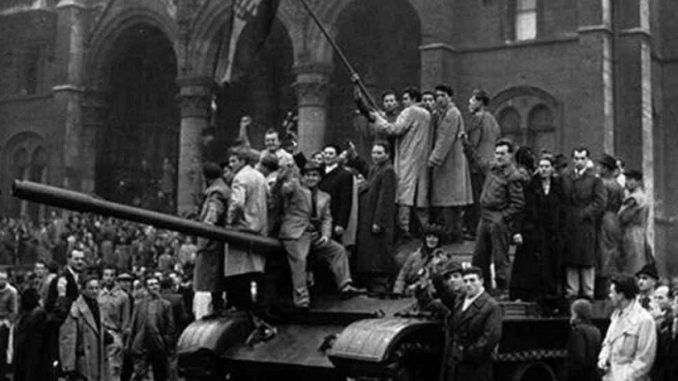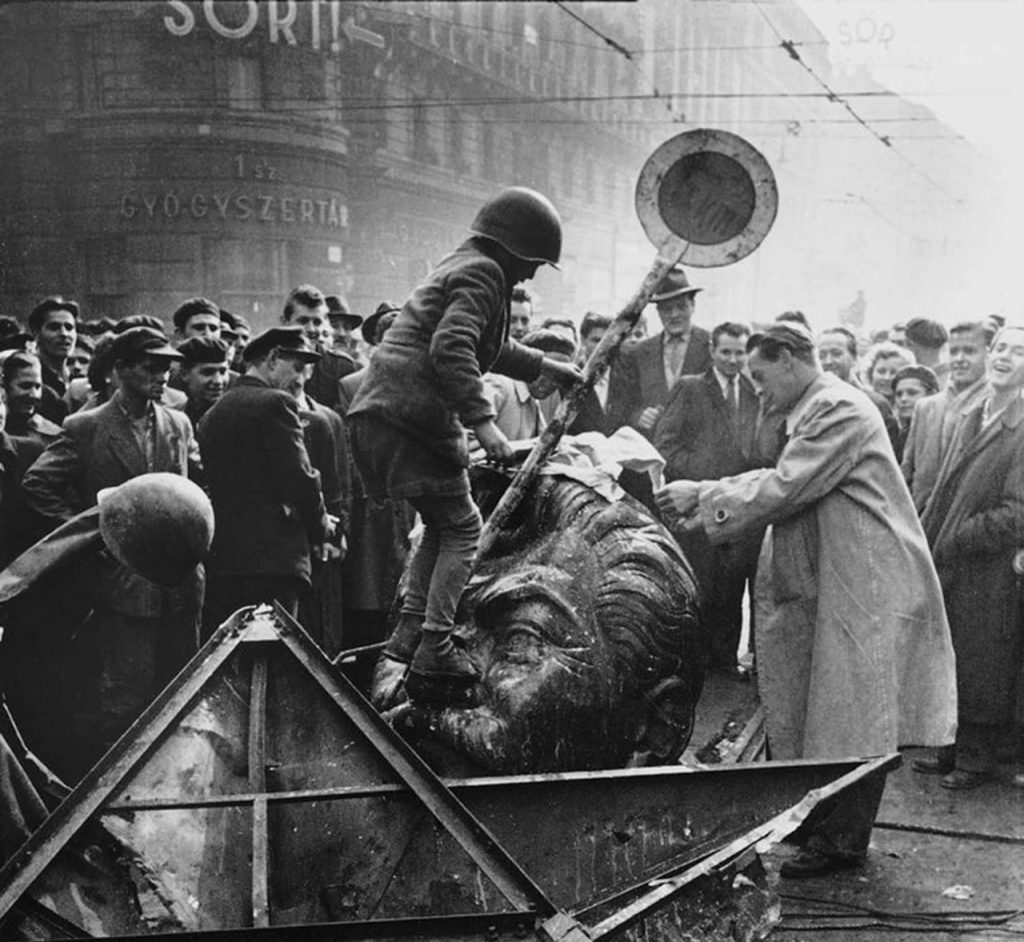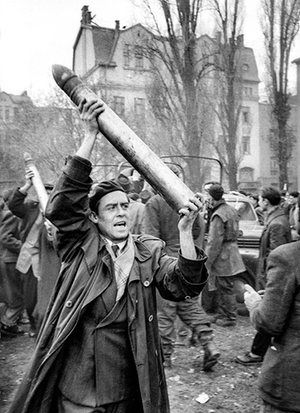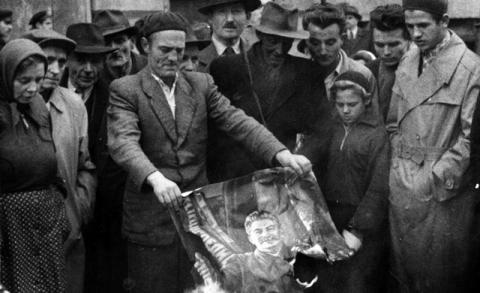
By Anabella Dalinger
Sixty-four years ago, a revolution developed in Hungary against the Stalinist bureaucratic regime, and was then crushed by soviet troops. The uprising began in Budapest, on the night of October 23, as a student protest demanding independence from the USSR, the withdrawal of Red Army troops and solidarity with demonstrations in Poland. It spread nationally with particular speed after the mobilization was brutally repressed and many of its activists jailed.
That same day the secretary of the Hungarian Communist Party, Erno Gerö, requested Soviet military intervention to “quell a demonstration that was reaching an unprecedented scale” and by 2 a.m. on October 24, the Soviet tanks were already in Budapest. The widespread repudiation of the occupation, the growing hunger and the hatred of the people for the number of executions turned into barricades. The troops, both in Budapest and in the provinces, were divided. Some were prepared to fight with the people; others were neutral, willing to hand over their weapons to the workers so that they could fight the secret police.

As a measure to contain the mobilization, János Kádár was retired and Imre Nagy, who had been expelled from office and from the Communist Party in 1953 as a traitor, returned to power at the head of a coalition cabinet, promising that the Red Army, which he had retired from Budapest, but was still in the country, would be definitely pulled out of Hungary.
On November 1, Nagy announced Hungary´s withdrawal from the Warsaw Pact, requesting the United Nations recognize Hungary as a neutral country under the protection of the great powers. On November 4, the Kremlin decided that it was time to crush the Hungarian people and mobilized the Soviet army with 31,550 soldiers and 1,130 tanks to Budapest and other regions of the country.
The resistance of the heroic Hungarian people continued until November 10 when a new “worker-peasant” government led by Janos Kadar and supported by the Soviet occupiers finally claimed that the “counterrevolution”, as they called the people who wanted to conquer their own government, had been defeated and order had been restored.
The Soviet leaders´ decision to intervene a second time brought despair, a virtual bankruptcy of the economy and a burning hatred of Russia and all things Russian in the hearts of the population. More than 20,000 Hungarians and 3,500 Russians are estimated to have died; tens of thousands were injured and large areas of Budapest were devastated. In addition, hundreds of thousands fled as refugees after the reestablishment of the occupation. (1)
A revolutionary stage
The process of ascent that crossed the world in the postwar period, with great expressions like the Chinese Revolution and the struggle for the independence of Algeria, Morocco and Tunisia, was also reflected in the Soviet zone. Workers on the offensive provoked discussions in the internatinoal left about the character of those uprisings.

On the one hand, there were those who said it was a small group of fascists, part of the international counterrevolution, and on the other, those who believed that the masses of eastern Europe were also on the offensive and wanted to conquer their own government. In order to expand its sphere of influence in the world, the Stalinist bureaucracy made a pact with imperialism – which by that time was terrified of uprisings – and surrendered the revolution, becoming the main support of the weakened capitalist regime in Europe. (2)
The miseries of the occupation and the totalitarian regime
Hungary, after the occupation, was forced to hand over 600 million dollars worth of reparations to the Soviet Union and to pay all the expenses of the Red Army stationed and in transit through the country. In the first year alone, 4 million tons of grain were expropriated to feed the troops. As in other Eastern European countries, the Russians formed mixed businesses in Hungary.
Of course, workers experience the miseries of any occupation: brutal production standards, miserable wages, imposition of language, confiscation of crops from peasants, and an overbearing policy for them to enter agricultural collectives. This nation-to-nation exploitation suffered by the peoples dominated by the Soviet Union was reflected in a totalitarian regime, which had nothing to do with socialism, without democracy and with the imposition of a bureaucracy invented in Moscow.
The prohibition of any type of discrepancy in the artistic, scientific and political field for thirty years, where everything was resolved through absolute unanimity, obscured a bloody political persecution and filled the prisons with genuine militants who dared to question the established order. The anti-Leninist policy of the bureaucracy, consisting of privileges for some and exploitation for workers, could only be sustained with terror because making State resources available for the people to freely express their opinions – the premise of Bolshevik democracy – threatened its power.
That totalitarian regime deepened more and more, and although until that moment it had not liquidated the great economic conquests of the October Revolution, like the nationalization of land, industries and foreign trade, or the total planning of the economy, it ended with the Leninist content of such conquests: the free and democratic intervention of the workers.
A national-workers revolution
The insurrectionary strikes in East Berlin in 1953 were an important precedent, and their defeat by the Soviet bureaucracy meant relative calm. The new stage, which began with the Hungarian Revolution in conjunction with the Polish Revolution, would become a true storm for Stalinism. The mass movement gathers confidence and organizes to jump to a new stage characterized by great national movements against oppression, exploitation and totalitarianism.
This enormous revolution had a double character: On the one hand, national, with the entire population intervening against the foreign oppressor. And on the other, working-class, when the movement advanced in the struggle not only against Russian exploitation but also against the bureaucracy of the country itself, leaving the working class as the only leadership.

Tendencies developed that expected the revolution against the bureaucracy to take a pacifist and reformist path. On the contrary, our current announced that the pressure of the mass movement was so strong that total confrontation was imminent and that this bureaucratic caste would not cease to be counterrevolutionary because there were no possibilities for its transformation.
The concessions of the Stalinist bureaucracy and the calm before the storm
Beginning with the XX Congress of the Communist Party of the Soviet Union, after the death of Stalin, the Russian bureaucracy tried to contain the struggle of the peoples oppressed by Russia by means of miserable concessions, but the promises of greater freedoms had only the objective of a better position from which to bargain with imperialism.
The Stalinist bureaucracy, with its characteristic of underestimating the mass movement, did not take into account that any attempt to relax its control would provide new momentum to move forward. Thus, the Hungarian Revolution inspired a generalized explosion against national oppression, social exploitation and political totalitarianism.
The revolutionary process revealed the common ground that existed between the Russian bureaucracy and Western imperialism, which cooperatied against the mass movement. The Church called for “social peace” though official propaganda attempted to demonstrate around the world that it had been the Church that had started the riots, in order to delegitimize them, since the Church was repudiated by the left worldwide.
The problem of the leadership
In the development of the struggle against Soviet occupation, exploitation and totalitarianism, clear manifestations of dual power emerged, a general characteristic of every country shaken by an intense revolutionary process. Most committee members were former members of the Social Democratic Party who, for one reason or another, had left political activity since the Communist Party and the Social Democratic Party had merged into the Hungarian Workers’ Party in June 1948.
Peter Fryer, Hungarian correspondent for the Communist newspaper Daily Worker described them during the process as: “organs of the insurrection – bringing together the elected delegates in factories, universities, mines and army units – and organs of popular self-government that enjoyed the confidence of the people in arms. As such they had tremendous authority, and it is no exaggeration to say that until the Soviet attack of November 4, real power in the country was in their hands.”
The Soviet Army crushed the revolution. The lack of a revolutionary party was a fundamental reason for which workers’ power could not prevail in Hungary. The communist parties and their organizations could not be transformed, rather, any change had to be made in spite of them, and any incipient organization could have militants who had belonged to its ranks, but necessarily had to be a new organization that looked for another channel.
Trotskyism, because of its weaknesses and lack of extension due to decades of Stalinist persecution, arrived in those conditions of weakness, while the workers of Hungary proclaimed in their broadcast of Radio Rajk, on November 1: “Those who in any way and in the name of any party cooperate with the occupying colonial power are traitors not only to Hungary, but to communism, and we must change them. Comrades, the place of every honest Hungarian communist is on the barricades.”
As in that event, today, the mass movement and the working class continue to fight against the persistent aftertaste of the Stalinist bureaucracy. The case of the rebellion in Belarus, as a current phenomenon, like the revolutionary episode in Hungary, continues to require a leadership so that, as Trotsky said, “…the energy of the masses does not dissipate, as the steam does not dissipate when contained in an engine.”
1 – PETER FRYER, The Hungarian Tragedy. 2- NAHUEL MORENO, The historical framework of the Hungarian revolution.








